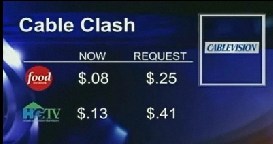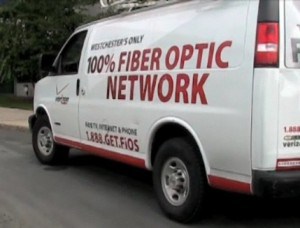 Negotiations between Scripps and Cablevision continue to drag on in the northeast as New York, Connecticut, and New Jersey Cablevision cable subscribers go without their HGTV and Food Network.
Negotiations between Scripps and Cablevision continue to drag on in the northeast as New York, Connecticut, and New Jersey Cablevision cable subscribers go without their HGTV and Food Network.
Progress has been incremental at best as Cablevision continues to refuse to accept paying the increased fees Scripps wants. Cablevision’s declaration that is expects to never carry Scripps programming again doesn’t help.
Meanwhile, Food Network president Brooke Johnson has been running from one news channel to another to talk about Scripps’ position on the dispute, and that “hundreds of thousands” of viewers have complained about the loss of their two networks, a number Cablevision disputes.
Pali Research analyst Richard Greenfield, who covers the cable industry, defended Cablevision, giving credit to the Dolan family that owns Cablevision for standing up to Scripps’ rate increase request.
Greenfield accused Comcast and Time Warner Cable of “essentially rolling over” in their negotiations with Scripps, agreeing to price hikes for their networks, an allusion to Time Warner Cable’s campaign to fight back against programmer price increases.
If those cable companies “had taken a far harder stance with Scripps, Cablevision’s pushback may actually have forced Scripps’ hand,” Greenfield wrote.
Still, most viewers could care less about the power plays between cable and the programmers. They just want their HGTV and Food Network back.
[flv]http://www.phillipdampier.com/video/WCBS New York Cablevision Scripps Dispute 1-4-10.flv[/flv]
WCBS-TV New York ran these two reports during their 6pm and 11pm newscasts describing the battle between Scripps and Cablevision, and consumer reaction. (4 minutes)
[flv width=”480″ height=”380″]http://www.phillipdampier.com/video/WTNH New Haven Cablevision Dispute 1-7-10.flv[/flv]
Same story, different city as WTNH-TV viewers in New Haven, Connecticut share their views on the dispute. (2 minutes)
[flv]http://www.phillipdampier.com/video/CNBC Brooke Johnson Cablevision Scripps Dispute 1-4-10.flv[/flv]
Food Network president Brooke Johnson appeared on CNBC to take questions about the dispute and changing business model of cable TV and programmers. (5 minutes)
[flv width=”640″ height=”380″]http://www.phillipdampier.com/video/Fox Business News Scripps Dispute With Cablevision 1-10.flv[/flv]
Johnson also turned up on Fox Business News to discuss the dispute, how negotiations are going, and how viewers are reacting. (6 minutes)
[flv width=”640″ height=”500″]http://www.phillipdampier.com/video/Bloomberg Brooke Johnson Cablevision Dispute 1-4-10.flv[/flv]
…And Johnson also appeared on Bloomberg News accusing Cablevision of paying themselves top dollar for AMC, a network they own, while refusing to negotiate over a price increase for the “more popular” HGTV and Food Network amounting “to pennies per subscriber.” (6 minutes)


 Subscribe
Subscribe




